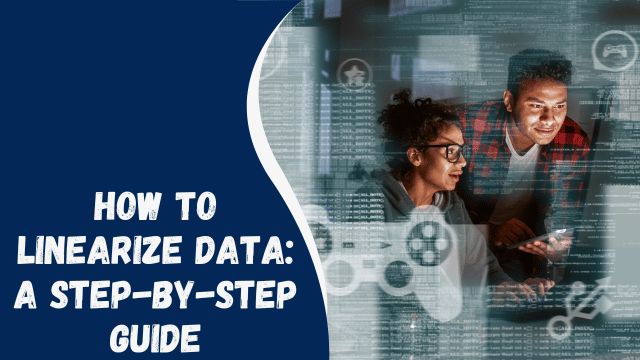How to Linearize Data: A Step-by-Step Guide

Contents
- 1 Introduction
- 2 Understanding Non-Linear Data
- 3 What is Non-Linear Data?
- 4 Challenges Posed by Non-Linear Data
- 5 Linearization Techniques
- 6 1. Logarithmic Transformation
- 7 2. Polynomial Regression
- 8 3. Box-Cox Transformation
- 9 4. Piecewise Linearization
- 10 The Linearization Process
- 11 Step 1: Data Collection
- 12 Step 2: Data Exploration
- 13 Step 3: Choose the Right Technique
- 14 Step 4: Apply Linearization
- 15 Step 5: Validate Linearity
- 16 Advantages of Linearization
- 17 Conclusion
- 18 FAQs
- 19 What if my data is extremely non-linear?
- 20 Can I use linearization for any type of data?
- 21 Are there any drawbacks to linearization?
- 22 What software tools can help with linearization?
Introduction
In the realm of data analysis, one common challenge is dealing with non-linear data. Non-linear data can make it difficult to draw meaningful insights or build accurate predictive models. However, there’s a solution: linearizing the data. In this article, we will explore what linearizing data means, why it’s essential, and how you can effectively linearize your data to improve your data analysis and modeling efforts.
Understanding Non-Linear Data
What is Non-Linear Data?
Non-linear data is data that does not follow a straight line when plotted on a graph. Instead, it exhibits curvature or irregular patterns. This kind of data can be problematic because many statistical and machine learning techniques assume linearity.
Challenges Posed by Non-Linear Data
Non-linear data presents several challenges, such as:
- Inaccurate Predictions: Predictive models often assume linearity. When your data is non-linear, your predictions may be less accurate.
- Complex Relationships: Non-linear data may indicate complex relationships between variables, making it harder to understand the underlying dynamics.
- Difficulty in Interpretation: Interpreting non-linear data can be tricky, leading to misinformed decisions.
Linearization Techniques
To make non-linear data usable, you can apply various linearization techniques:
1. Logarithmic Transformation
In cases where the data exhibits exponential growth, taking the logarithm of the values can often linearize the relationship.
2. Polynomial Regression
Polynomial regression fits a polynomial equation to your data, allowing you to capture non-linear relationships.
3. Box-Cox Transformation
The Box-Cox transformation is used when data exhibits different types of non-linearity. It optimizes the data’s transformation to achieve linearity.
4. Piecewise Linearization
Divide your data into segments and fit linear models to each segment, effectively linearizing the entire dataset.
The Linearization Process
Now that we’ve covered some techniques let’s dive into the step-by-step process of linearizing data.
Step 1: Data Collection
Begin by collecting your data and organizing it in a structured manner. Ensure you have all the necessary variables.
Step 2: Data Exploration
Visualize your data to identify non-linear patterns. Create scatter plots and histograms to gain insights into its distribution.
Step 3: Choose the Right Technique
Based on your data exploration, select the most suitable linearization technique. Consider factors like data distribution and the underlying relationships.
How to Flush Topamax Out of Your System
Step 4: Apply Linearization
Implement the chosen technique to linearize your data. This may involve mathematical transformations or modeling.
Step 5: Validate Linearity
After linearization, re-plot your data to confirm that it now follows a linear trend. This step is crucial to ensure the success of your analysis.
Advantages of Linearization
Linearizing data offers several benefits:
- Improved Predictive Models: Linear data is more compatible with traditional modeling techniques, leading to better predictions.
- Simplified Interpretation: Linear relationships are easier to interpret and explain, making your findings more accessible.
- Enhanced Statistical Testing: Linear data allows for the use of common statistical tests with confidence.
Conclusion
In the world of data analysis, linearizing non-linear data is a valuable skill. It opens up the door to better insights, predictions, and decision-making. By following the steps outlined in this article and selecting the right linearization technique, you can harness the power of linearity in your data and unlock its full potential.
FAQs
What if my data is extremely non-linear?
In such cases, you may need to consider advanced techniques or seek expert assistance to linearize the data effectively.
Can I use linearization for any type of data?
Linearization techniques are most effective when dealing with continuous data that exhibits non-linear patterns.
Are there any drawbacks to linearization?
Linearization may simplify data but can also introduce some bias. It’s essential to weigh the pros and cons based on your specific analysis goals.
What software tools can help with linearization?
Many data analysis tools like Python with libraries such as NumPy and SciPy, or R with ggplot2, can assist in linearization.





